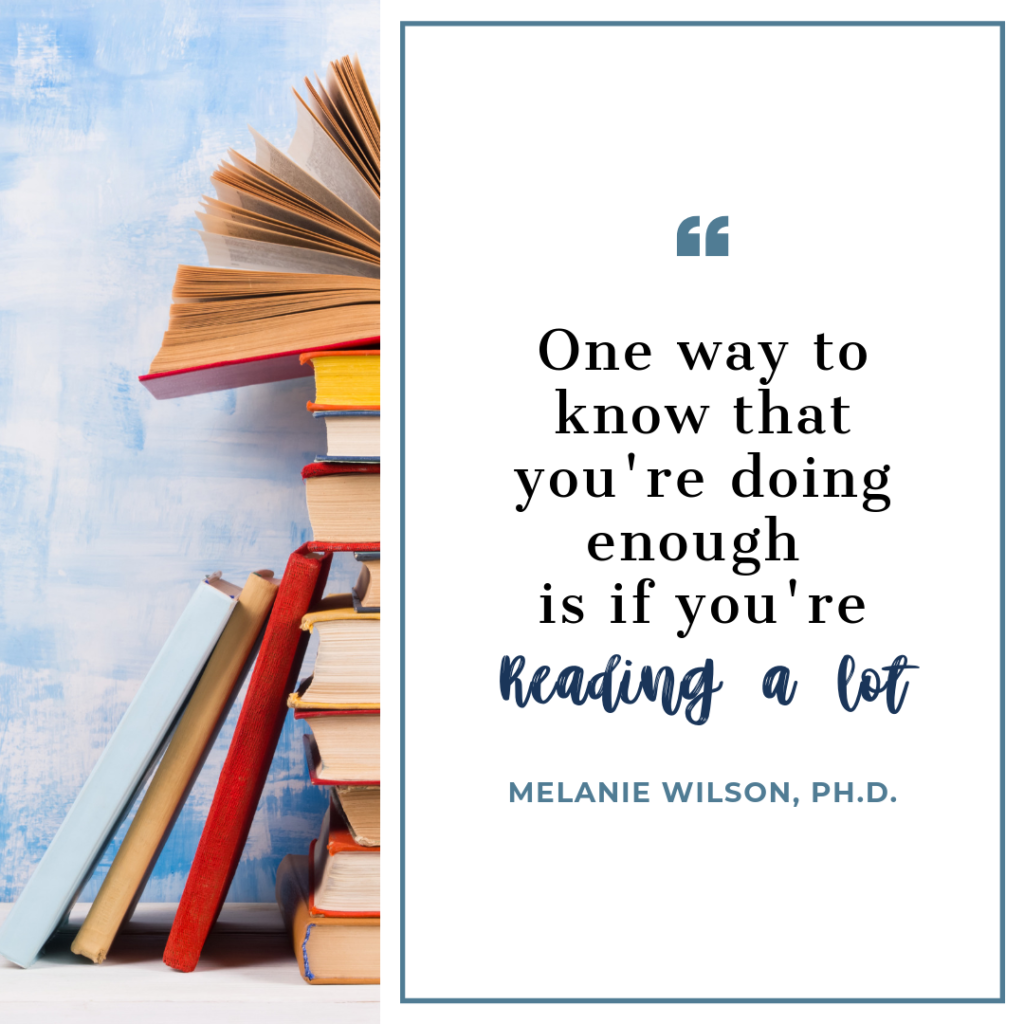 One of the most common concerns I hear from new homeschoolers is whether or not they’re doing enough. If that’s your question, regardless of how long you’ve been homeschooling, I have six ways you can know that you’re doing enough in your homeschool.
One of the most common concerns I hear from new homeschoolers is whether or not they’re doing enough. If that’s your question, regardless of how long you’ve been homeschooling, I have six ways you can know that you’re doing enough in your homeschool.
#1 Know you’re doing enough in your homeschool by comparing your plans to policies
The first way to know if you’re doing enough in your homeschool is to compare your plans with your state or charter school’s policies. Many homeschoolers are surprised to learn how few guidelines there really are for what to teach. I recommend that you visit HSLDA (the Homeschool Legal Defense Organization). This website lists homeschooling laws by state and also has curriculum guidelines for high schoolers – another area that causes homeschoolers a great deal of anxiety.
If you are doing what the laws or guidelines suggest, you can take a deep breath and relax. The standards set by others are typically much lower than the standards we set for ourselves. I am not suggesting that we do the least amount possible. We want our kids to have a rich, quality education. But neither am I suggesting that we should do every subject and use multiple curricula and classes to teach these subjects. I am here to promote homeschool sanity, and that’s the quickest way to the homeschool loony bin. Instead, use the standards to reassure yourself that you are in fact doing enough.
#2 Know you’re doing enough by comparing your hours
The second way to know if you’re doing enough is to consider the number of hours you might spend on direct teaching by the age of your child. RaisingArrows.net says that formal homeschooling takes 30-45 minutes for kindergarten and first grade, 1.5-2 hours for second to fourth grade, 2-4 hours for 5th & 6th grade, and 4+ hours for 7th grade and up. That doesn’t sound like a lot, does it?
My state requires 1000 hours of instruction. Let’s have a reasonable view of what that means. It does not mean that I must stand at my whiteboard lecturing for a thousand hours a year. Public school teachers are not held to that standard. In fact, public schools operate a bit more like I did when I practiced as a clinical psychologist. A counseling hour was really 45 minutes with ten minutes of that taken up with greetings and good-byes. Traditional school students spend time using the restroom, walking the hallway, staring out the window…you get the idea. We also have an advantage over traditional teachers in that we can count many informal activities as educational hours. Have your kids help you make dinner and if you are teaching as you go, you have life skill hours. When your child is reading the manual to understand a new game or toy that has been purchased, you have reading time. If you are balking at the suggestion that reading manuals counts as educational time, know that Common Core standards introduced the idea that this type of reading was valuable for students. I agree, but I don’t think it should replace literature. As homeschoolers, it certainly doesn’t have to.
I homeschooled for many years before I understood that educational hours did not always have to involve me. Kids can read and work independently. They can take classes, participate in extracurricular activities, and even help teach siblings. Begin to expand your definition of education, and you will be more confident that you are doing enough.
#3 Know you’re doing enough by developing key skills
The third way you can know you’re doing enough is if you are spending time developing key skills. My previous point may have had you thinking about unschooling. If you’re interested in unschooling, I recommend my podcast interview with Karla Marie Williams. No matter how strictly you adhere to the unschooling philosophy, I believe it’s critical that we spend time developing key skills. Even if you don’t think your child needs to learn handwriting until middle school, Grandma may believe otherwise and give you a hard time. Your child may be thoroughly embarrassed if she doesn’t know her math facts while playing a game with friends. And while many children develop the ability to read later, it is critical that we spend time developing phonics and fluid reading skills in our students. You may choose to develop reading, handwriting, and math knowledge in whichever way you choose. Have your child use games to learn phonics. Use online programs like Starfall for reading. Or use a book like Teach Your Child to Read in 100 Easy Lessons. Whatever you choose, reading instruction is not optional in my opinion.
Handwriting too is an essential skill. I’ve learned over the years of homeschooling five boys that slow handwriting results in reluctance to do any type of seatwork. In fact, even math homework can be a struggle if kids are not able to write their numerals quickly. Choose the handwriting approach that works for you. Teach your kids to form the letters by writing in Cool Whip, use the handwriting app on your iPad, or use formal curriculum like Handwriting Without Tears. Whatever you do, have your child practice for short periods and consistently.
The next area that I believe is critical for our students to learn is math facts. Some homeschoolers have told me that they don’t believe learning math facts is important in the age of calculators. I couldn’t disagree more. Have you ever made a mistake with calculators? I do it all the time. When I am totaling my sales at conventions and I am told that I had $300,000 in sales, I am not hooting and hollering. Instead, I groan and know that I have to re-calculate. If your kids don’t know math facts, higher level math will be impossible. Without memorizing basic math facts, your child will be that cashier who panics when the cash register doesn’t tell her how much change to give you back. Again, you choose how to have your child master math facts. Use flashcards, stories, games, or competition to complete math fact quizzes in a short period of time as is taught by Learn Math Fast. But make the acquisition of math facts a priority in your homeschool.
#4 Know you’re doing enough by covering some subjects every other year
The fourth way to know if you’re doing enough is you are covering subject areas like social studies, science, and fine arts at least every other year. One of the mistakes I made as a beginning homeschooler is I thought I had to teach every conceivable subject every year. That is a recipe for homeschool burnout. Public schools do not teach calligraphy, map memorization, and astronomy, in addition to all the core subjects they have to cover to meet standards.
If you want to study one or more of these things, make room for it in your homeschool schedule. I love history. But I didn’t realize that I was not required to teach it every single year. The same with science. These subjects and even fine arts will be a part of your homeschool education even if they are not a specific focus. Field trips we have taken almost always incorporate history. My kids did science experiments of their own for fun. In the YouTube age, that’s even more likely. And art and music appreciation can be incorporated into a fun Friday rather than being a specific course.
I know, I know. I want to do it all too. And we we can do a lot. Just not all this year. Just not all this week. If you’re struggling to determine which curriculum to use, I recommend that you read the article I wrote on curriculum paralysis.

#5 Know you’re doing enough if you’re reading a lot
The fifth way to know you’re doing enough is that you and your kids are reading a lot. Reading is the gold standard for education. In truth, we can teach our kids all the other subject areas with reading alone. Sure, mapping, experiments, and writing are important too. But primary education is to be found in books.
I learned best by reading. In fact, my teen son asked me while I was cutting his hair how I had learned to cut hair. I explained that I found a very old book at a used book sale and that was all I needed. If your child is not a verbal learner, audiobooks can be a huge help. I have spoken before about the benefits of audiobooks and reading aloud for building vocabulary.
If you are in a challenging time in your homeschool because you’re pregnant, traveling, or caring for an ill family member, focus on reading. It will be enough.
#6 Know you’re doing enough by talking to veteran homeschoolers
The final way to know you’re doing enough is to talk to veteran homeschoolers. I laughed so hard when my new homeschooling friend was worried that her son wasn’t willing to follow her plan. Of course he wasn’t. It was too much and I empathetically told her so.
Sure, there are homeschoolers online who present their homeschools as though they’re reading a novel or two aloud to their family each day, reenacting a new war every weekend, and building a life-sized model of the ark this month. But most homeschoolers will be honest about what they are able to accomplish. I trust the members of The Homeschool Sanity Circle on Facebook to be real with you. They will read your plan and will tell you if you’re doing enough or more likely that you’re trying to take on too much.
Conclusion
In conclusion, if you are following your state’s or charter school’s guidelines, spending a reasonable number of hours on school for your kids’ ages, teaching key skills, covering other subject areas at least every other year, reading a lot, and you’ve gotten the green light from veteran homeschoolers, you can rest assured that you’re doing enough.









